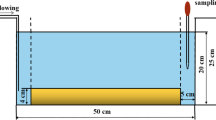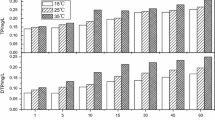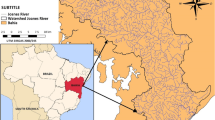Abstract
Purpose
Aluminum-based P-inactivation agent (Al-PIA) is a promising water treatment material, which has often been used for eutrophication restoration of water bodies. Numerous studies have shown that Al-PIA can control the release of phosphorus from sediment. However, whether the Al-PIA will destroy the bacterial community structure in sediment when it is used for capping of sediment and controlling the release of phosphorus from the sediment remains unknown. Therefore, this work aimed to study the effect of thin Al-PIA capping on bacterial communities in sediments.
Methods
This study used the surface sediment of a lake as the research object. The bacterial community structure of the sediments before and after the Al-PIA capping was analyzed by Illumina Genome Analyzer IIx. The community succession rule of the sediment bacterial in Al-PIA capping system was studied, and the influence of Al-PIA capping on the bacterial community structure in sediments was analyzed.
Results and discussion
The test lasted for 45 days. The results showed that the Shannon index, Ace index, and Chao1 index of the capping system were larger than those of the control system. The diversity and abundance of the sediment bacterial community increased significantly. In the Al-PIA capping system, Proteobacteria, Bacteroides, Cyanobacteria, and Nitrospirillum were feature bacterial phyla. Meanwhile, Denitratisoma, Dechloromonas, and Cetobacterium were feature bacterial genus.
Conclusion
Although Al-PIA capping had a certain impact on the bacterial community structure of sediment, it basically did not destroy the stability of the ecosystem and enhanced the self-purification ability of the water bodies. The results can provide theoretical guidance for the practical use of Al-PIA for sediment restoration.







Similar content being viewed by others
References
Al-Tahmazi T, Babatunde AO (2016) Mechanistic study of P retention by dewatered waterworks sludges. Environ Technol Inno 6:38–48
Babatunde A, Zhao Y, Burke A, Morris M, Hanrahan J (2009) Characterization of aluminium-based water treatment residual for potential phosphorus removal in engineered wetlands. Envirol Pollut 157:2830–2836
Bai X, Lin J, Zhan Y, Chang M, Xin H, Wu J (2020) Use of iron-modified calcite as an active capping material to control phosphorus release from sediments in surface water bodies. Environ Sci 41:1296–1308
Bjornsson L, Hugenholtz P, Tyson GW, Blackall LL (2002) Filamentous Chloroflexi (green non-sulfur bacteria) are abundant in wastewater treatment processes with biological nutrient removal. Microbiology 148:2309–2318
Chai B, Wang S, Li S, Lei X, Li M (2021) Roles of bacterial biomass, physiology and community in sediment phosphorus solubilizing at varying hydrostatic pressures. J Clean Prod 282:124531
Chen W, Hu F, Li X, Yang W, Feng S, Yang D, Pang W, Lu B (2021) Deciphering the mechanism of medium size anammox granular sludge driving better nitrogen removal performance. Bio Technol 336:125317
Chen X, Jiang N, Chen Z, Tian J, Sun N, Xu M, Chen L (2017) Response of soil phoD phosphatase gene to long-term combined applications of chemical fertilizers and organic materials. Appl Soil Ecol 119:197–204
Ding S, Sun Q, Chen X, Liu Q, Wang D, Lin J, Zhang C, Tsang D (2018) Synergistic adsorption of phosphorus by iron in lanthanum modified bentonite (Phoslock): new insight into sediment phosphorus immobilization. Water Res 134:32–43
Feng D, Wu Z, Xu S (2008) Nitrification of human urine for its stabilization and nutrient recycling. Bio Technol 99:6299–6304
Fraser T, Lynch D, Entz M, Dunfield K (2015) Linking alkaline phosphatase activity with bacterial phoD gene abundance in soil from a long-term management trial. Geoderma 257:115–122
Gerritsen J, Umanets A, Staneva I, Hornung B, Ritari J, Paulin L, Rijkers G, Vos W, Smidt H (2018) Romboutsia hominis sp. nov., the first human gut-derived representative of the genus Romboutsia, isolated from ileostoma effluent. Inter J System Evol Microbiol 68:3479–3486
Huang T, Zhou Z, Su J, Dong Y, Wang G (2013) Nitrogen reduction in a eutrophic river canal using bioactive multilayer capping (BMC) with biozeolite and sand. J Soils Sediments 13:1309–1317
Jin Z, Liu Z, Tang Y, Guan B, Liu Z, Ren L (2020) Effect of different ecological treatment methods on microbial community in black and odorous sediment of urban river. J Lake Sci 32:754–761
Kim JG, Kim JH, Moon H, Chon C, Ahn J (2002) Removal capacity of water plant alum sludge for phosphorus in aqueous solutions. Chem Spec Bioavailab 14:67–73
Lee IS, Parameswaran P, Rittmann BE (2011) Effects of solids retention time on methanogenesis in anaerobic digestion of thickened mixed sludge. Bio Technol 102:10266–10272
Li B, Zhou Z, Ravi N, Hu Z, Guo D, Chen J (2021) Combined remediation of eutrophic water by phoslock® and aerobic denitrifying bacteria. Environ Sci 42:1861–1869
Li S, Zhou Z, Yang S, Liu S, Yuan B (2019) The efficiency of controlling the phosphorus release from the sediment using calcined modified water purification plant sludge (C-WTPS). J Lake Sci 31:961–968
Liu C, Zhu Y, Wang J, Guan J, Sui H (2018a) Impact of tail water discharged on bacterial community structure in river in different seasons. Res Environ Sci 31:893–900
Liu Q, Zhou Z, Zhang H, Fei X, Xie J, Li S, Yuan B (2018b) Parameter optimization of preparing phosphorus removal material by using calcined water treatment plant sludge. J Huaqiao Univ (natural Sci) 39:51–56
Liu Q, Zhou Z, Zhang H, Fei X, Xie J, Li S, Yuan B (2019) Phosphorus removal characteristics of calcined water treatment plant sludge. Environ Sci 38:325–333
Lürling M, Tolman Y (2010) Effects of lanthanum and lanthanum-modified clay on growth, survival and reproduction of Daphnia magna. Water Res 44:309–319
Liu X, Xie D, Li K, Zhou W, Wang H (2013) Influence of application of bio-energizer to sediment microbial community and the content of nitrogen and phosphorus element. China Environ Sci 33(S1):87–92
Makiko I, Takayuki N (2013) Suppression of phosphorus release from sediments using water clarifier sludge as capping material. Environ Technol 34:2291–2299
Medinger R, Nolte V, Pandey RV, Jost S, Ottenwlder B, Schltterer C, Boenigk J (2010) Diversity in a hidden world: Potential and limitation of next-generation sequencing for surveys of molecular diversity of eukaryotic microorganisms. Mol Ecol 19:32–40
Petriglieri F, Singleton C, Peces M, Petersen JF, Nierychlo M, Nielsen PH (2021) “Candidatus Dechloromonas phosphoritropha” and “Ca. D. Phosphorivorans”, novel polyphosphate accumulating organisms abundant in wastewater treatment systems. ISME J 15:3605–3614
State Environmental Protection Administration (SEPA) of China (2002) Monitoring and analyzing methods of water and wastewater. China Environmental Science Press Beijing (4th ed.)
Sun G, Liu Y, Wang L (2019) Effect of modified zeolite covering on microbial community in sediment. Acta Sci Circumst 39:1554–1561
Tu L, Jarosch KA, Schneider T, Grosjean M (2019) Phosphorus fractions in sediments and their relevance for historical lake eutrophication in the Ponte Tresa basin (Lake Lugano, Switzerland) since 1959. Sci Total Environ 685:806–817
Van Oosterhout F, Lürling M (2013) The effect of phosphorus binding clay (Phoslock®) in mitigating cyanobacterial nuisance: a laboratory study on the effects on water quality variables and plankton. Hydrobiologia 710:265–277
Waajen G, Van Oosterhout F, Douglas G, Lürling M (2016) Management of eutrophication in Lake De Kuil (The Netherlands) using combined flocculant - lanthanum modified bentonite treatment. Water Res 97:83–95
Wang CH, Wu Y, Wang YQ, Bai LL, Jiang HL, Yu JH (2018a) Lanthanum-modified drinking water treatment residue for initial rapid and long-term equilibrium phosphorus immobilization to control eutrophication. Water Res 137:173–183
Wang JL, Fu ZS, Qiao HX, Liu FX (2018b) Assessment of eutrophication and water quality in the estuarine area of Lake Wuli, Lake Taihu, China. Sci Total Environ 650:1392–1402
Wang X, Li J, Li S, Zheng X (2017) A study on removing nitrogen from paddy field rainfall runoff by an ecological ditch-zeolite barrier system. Environ Sci Pollut R 24:1–14
Wang Y, Meng G, Shan, M, Wang D, Bai J (2020) Treatment of high-ammonia-nitrogen landfill leachate nanofiltration concentrate using an Fe-loaded Ni-foam-based electro-Fenton cathode. J Envirol Chem Eng 8(5):104243
Wu H, Wang J, Duan E, Hu W, Dong Y, Zhang G (2020) Phosphorus removal by adsorbent based on poly-aluminum chloride sludge. Water Sci Eng 13:193–201
Wu P, Lu S, Xu L, Liang Q, Shen Y (2017) Efficiency and mechanism of nitrogen and phosphorus removal in modified zeolite wetland. Environ Sci 38:580–588
Xie M, Zhou W, Xie Y, Li Y, Zhang Z, Yang Y, Olsen RE, Ran C, Zhou Z (2021) Effects of Cetobacterium somerae fermentation product on gut and liver health of common carp (Cyprinus carpio) fed diet supplemented with ultra-micro ground mixed plant proteins. Aquaculture 543:736943
Xing M, Xie Q, Chen S, Wu D (2019) Preparation of the silane monolayer on magnetite manoparticles and its performance with respect to phosphate removal from water. Environ Sci 40:310–318
Yang C, Zhong Z, Zhang X, Bian F, Du X (2018) Responses of soil organic carbon sequestration potential and bacterial community structure in moso bamboo plantations to different management strategies in subtropical China. Forests 9:657
Yang G, Bao B, Peatman E, Li H, Huang L, Ren D (2007) Analysis of the composition of the bacterial community in puffer fish Takifugu obscurus. Aquaculture 262:183–191
Yi F, Li Y, Wu D, Li C, Hainan K (2017) Application of zeolite/hydrous zirconia composite as a novel sediment capping material to immobilize phosphorus. Water Res 123:1–11
Yin H, Yang P, Kong M, Li W (2020) Use of lanthanum/aluminum co-modified granulated attapulgite clay as a novel phosphorus (P) sorbent to immobilize P and stabilize surface sediment in shallow eutrophic lakes. Chem Eng J 385:123395–123406
Yu X, Zhang P, Zhang J, Chen F, Yang Y (2020) Characteristics of distribution patterns of microbial biomass and community structures in the sediments from urban river. Acta Sci Circumst 40:585–596
Yu YH, Chen C, Wu YG, Yu LF (2015) The effect of covering on sediment in a canyon type lake under the anaerobic condition. Environ Eng 33:53–57
Zhang H, Chen S, Wang B, Li M, Zhou M, Zhou R, Yang J, Song T (2019a) Purification effect of combined artificial wetlands on dispersed domestic sewage and analysis of microbial community structure. Environ Chem 38:2535–2545
Zhang H, Wang L, Li Y, Chao P (2019b) Background nutrients and bacterial community evolution determine 13C-17β-estradiol mineralization in lake sediment microcosms. Sci Total Environ 651:2304–2311
Zhang H, Wang Y, Chen S, Zhao Z, Feng J, Zhang Z, Lu K, Jia J (2018) Water bacterial and fungal community compositions associated with urban lakes, Xi’an, China. Int J Environ Res Pub He 15:469
Zhang M, Wu Z, Sun Q, Ding Y, Sun L (2019c) The spatial and seasonal variations of bacterial community structure and influencing factors in river sediments. J Environ Manage 248:109293
Zhang Y, Ding J, Zhang X, Lu X, Zhu L, Zhang H (2021) Adsorption properties of high efficient lanthanum-loaded zeolite-chitosan composite absorbent for phosphorus removal. Acta Sci Circumst 41(2):557–565
Zhou SL, Sun Y, Huang TL, Cheng Y, Yang X, Zhou ZZ, Li Y, Li ZX, Cui JS, Luo X (2020) Reservoir water stratification and mixing affects microbial community structure and functional community composition in a stratified drinking reservoir. J Environ Manage 267:110456
Zhou T, Ding Y, Wan Q, Li S, Chai B, Lei X (2021a) Effects of hydrostatic pressure on phosphorus transformation at the water-sediment interface of a deep reservoir: novel insights into bacterial community and functional genes. J Soils Sediments 21:3367–3379
Zhou Z, Huang T, Yuan B (2016) Nitrogen reduction using bioreactive thin-layer capping (BTC) with biozeolite: A field experiment in a eutrophic river. J Environ Sci 42:1119–1125
Zhou Z, Lin C, Li S, Liu S, Yuan B (2021b) Four kinds of capping materials for controlling phosphorus and nitrogen release from contaminated sediment using a static simulation experiment. Front Environ Sci Eng 16:29–38
Zhou Z, Liu Q, Li S, Li F, Zou J, Liao X (2018) Characterizing the correlation between dephosphorization and solution pH in a calcined water treatment plant sludge. Environ Sci Pollut R 25:18510–18518
Zhou Z, Liu Q, Liu T, Huang H, Ma H, Zeng Q, Yuan B (2017) Thin-layer capping with biozeolite for nitrogen load reduction in the water-supply source reservoirs, subtropical China. J Lake Sci 29:567–574
Zhu B, Li S, Lin C, Liu S, Zhou Z (2021) The effect of secondary capping on the control of phosphorus release from sediment by activated thin-layer capping with Al-PIA. Environ Sci Pollut R 24:1–8
Zhu D, Liu J, Han R, Shen G, Yang F, Long Q, Liu D (2012) Population diversity and phylogeny of halophiles in the Qinghai Lake. Bio Sci 20:495–504
Zhu J, Qin H, Sun Q, Wang B, Gao R, Guo R, Li W (2020) Microbial diversity and influencing factors in a small watershed in winter. Environ Sci 41:5016–5026
Funding
This work was supported by the National Natural Science Fund of China (Grant No. 51878300), the Natural Science Foundation of Fujian Province of China (Grant No. 2019J01052), and the Science and Technology Project Foundation of Xiamen City (Grant No. 3502Z20203044).
Author information
Authors and Affiliations
Corresponding author
Ethics declarations
Conflict of interest
The authors declare no competing interests.
Additional information
Responsible editor: Haihan Zhang
Publisher's Note
Springer Nature remains neutral with regard to jurisdictional claims in published maps and institutional affiliations.
Rights and permissions
About this article
Cite this article
Wang, Y., Yuan, S., Liu, S. et al. Effect of aluminum-based P-inactivation agent (Al-PIA) capping on bacterial community in sediment. J Soils Sediments 22, 1344–1354 (2022). https://doi.org/10.1007/s11368-022-03151-w
Received:
Accepted:
Published:
Issue Date:
DOI: https://doi.org/10.1007/s11368-022-03151-w




